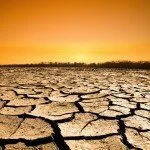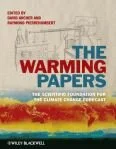From rising temperatures to rising seas, the consequences of global warming are here now, and predictions for the future are dire. In his review “Drought under global warming,” UCAR author Aiguo Dai indicates that yet another consequence is already affecting our planet and, over time, will almost certainly become more severe: worldwide drought.
 Wait, drought is already a problem?
Wait, drought is already a problem?
Research by Dai and other scientists shows that drought has increased worldwide over the last century. In one 2004 study, Dai showed that between 1870 and 2002, the percentage of land around the globe affected by serious drought more than doubled. In a later study, he examined 925 of the earth’s largest rivers and found a 30% decrease in water levels over the last 50 years.
So what does the future look like?
In his most recent study, Dai used projections about temperature, precipitation, humidity, wind speed, and Earth’s radiative balance to predict future drought locations and severities. In order to classify drought severity, Dai used the Palmer Drought Severity Index (PDSI): an index that tracks precipitation and evaporation over time and compares these measures to what would normally be expected in a particular region. A reading of +0.5 to -0.5 indicates normal conditions; a reading at or below -4 indicates extreme drought. By the 2030s, Dai’s projections show PDSI readings dropping to -4 to -6 over most of the western two-thirds of the United States, and -8 or lower in regions bordering the Mediterranean Sea. Large parts of Latin America, southern Asia, Africa, and Australia face significant drought risks, as well.
What can we do about it?
Geoengineering offers a number of large-scale solutions to global warming (and, consequently, the drought caused by it). These solutions fall into two main categories:
- CO2 Capture: removing carbon dioxide from the atmosphere. Methods include planting forests, using biofuels, and building carbon-scrubber towers to capture CO2 from the air. These are generally viewed as safe and technically feasible; however, they are also criticized as being too slow to take effect.
- Solar Radiation Management : reflecting sunlight back into the sky, which would lower the Earth’s temperature. Methods include using space mirrors; scattering fine white reflective particles of sulfate high into the stratosphere; or using ships to spray water and generate reflective low-altitude clouds. These can be implemented quickly; however, they run higher risks of disrupting the Earth’s ecosystems and causing other unforeseeable damage to the planet.
 On a smaller scale, individuals can combat global warming with their own actions. The Union of Concerned Scientists (UCS) makes a number of suggestions, including using low- or no-emission tools, fertilizer, and pest control; planting shrubs and trees; composting organic waste; and watering plants during the coolest part of the day.
On a smaller scale, individuals can combat global warming with their own actions. The Union of Concerned Scientists (UCS) makes a number of suggestions, including using low- or no-emission tools, fertilizer, and pest control; planting shrubs and trees; composting organic waste; and watering plants during the coolest part of the day.
Read Dai’s most recent study, “Drought under global warming: a review,” freely accessible on WIREs.
Learn more about climate change and global warming at the University Corporation for Atmospheric Research (UCAR) website.
Find more suggestions from the UCS in their guide The Climate Friendly Gardener.
 Check out Hack the Planet: Science’s Best Hope – or Worst Nightmare – for Averting Climate Catastrophe Check out Hack the Planet: Science’s Best Hope – or Worst Nightmare – for Averting Climate Catastrophe
by Eli Kintisch to learn more about geoengineering techniques for worst-case climate scenarios. |
 Look for The Warming Papers
Look for The Warming Papers
edited by David Archer and Ray Pierrehumbert, coming in January 2011.
1. Dai, A., Trenberth, K., & Qian, T. (2004). A Global Dataset of Palmer Drought Severity Index for 1870–2002: Relationship with Soil Moisture and Effects of Surface Warming Journal of Hydrometeorology, 5 (6) DOI: 10.1175/JHM-386.1
2. Dai, A., Qian, T., Trenberth, K., & Milliman, J. (2009). Changes in Continental Freshwater Discharge from 1948 to 2004 Journal of Climate, 22 (10), 2773-2792 DOI: 10.1175/2008JCLI2592.1
3. Dai, A. (2010). Drought under global warming: a review Wiley Interdisciplinary Reviews: Climate Change DOI: 10.1002/wcc.81
